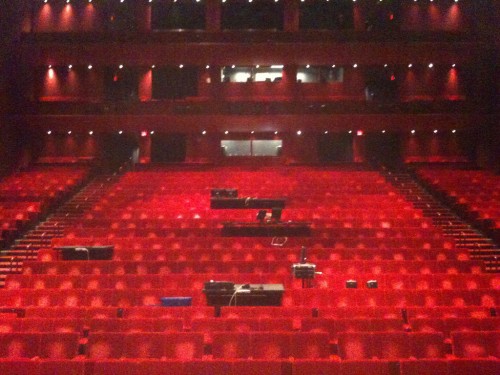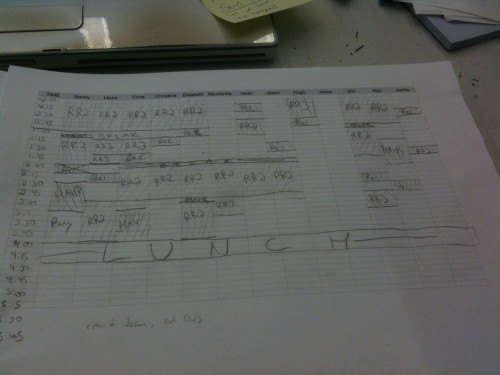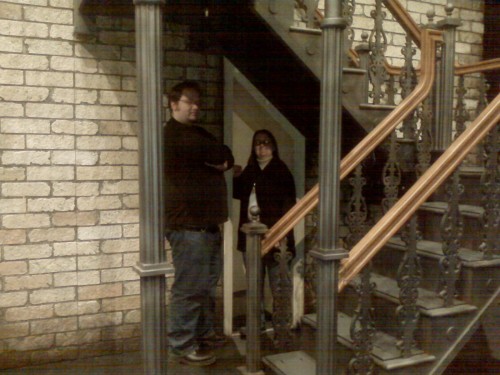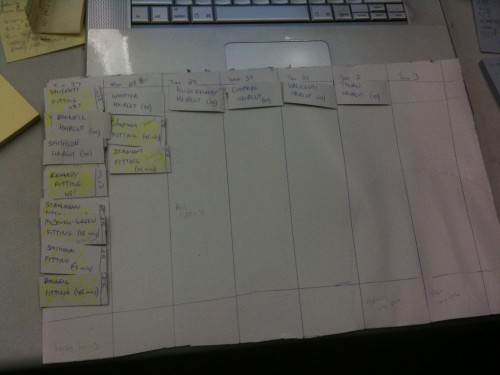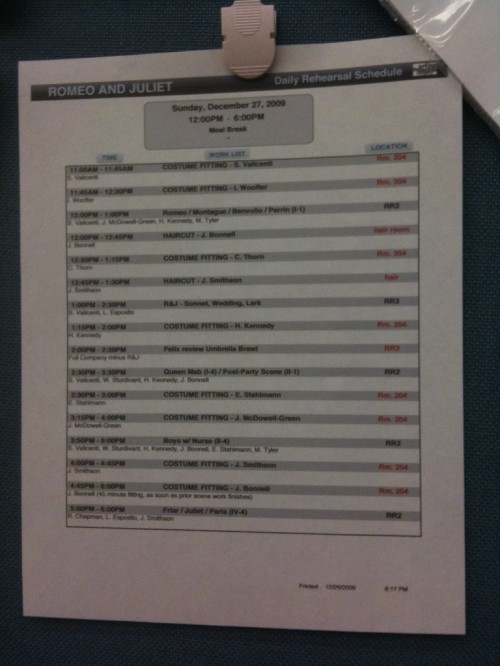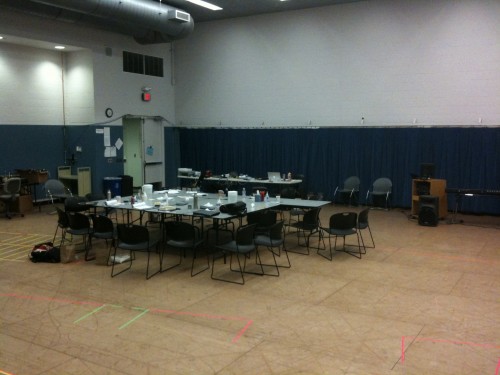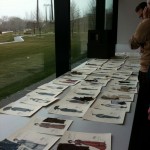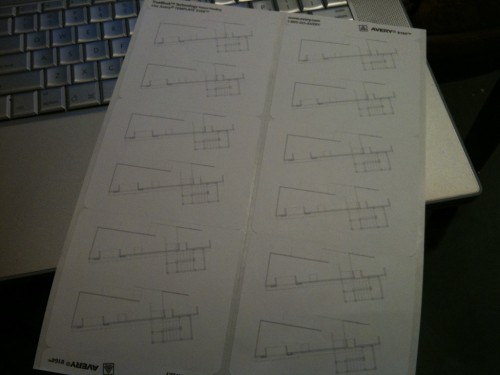Today marks the halfway point in our stay in Minneapolis. We arrived here December 1st, and we depart on January 31st, for our next performance in Moorhead, MN (right next to Fargo, apparently), on February 1st.
As one would assume, we are about to go into tech. Nick, Ashley and I will pack up the rehearsal room on Saturday night, and all of our stuff will be moved up to the theatre on Sunday morning. Sunday is a regular rehearsal day, but instead of being in our rehearsal studio, we will be on stage. Our local carpenters, Craig and Sarah, will be there with us for the first time, where they will begin learning the show, and becoming familiar with the props. I’m sure they already know the set better than us since they put it up.
Sunday’s rehearsal is about spacing, getting used to the ins and outs of the set, and troubleshooting any problems we discover in the course of that.
We have Monday off, during which the crew will complete everything that remains to be done before tech, and then on Tuesday morning we have our first day of tech.
My Team
Although being away from our company’s base of operations has its challenges, one of the things that has helped me stay reasonably sane is that I have a stage management team I trust. At this point Nick and I have been working together long enough that we often think of things at exactly the same time. This year we are taking part in the Guthrie system of using Google Talk to communicate in the rehearsal room and between departments and other shows. Usually at least once a day, Nick and I will type the same thing into Google Talk and send it to each other simultaneously. Yesterday I caught us both letting out an exasperated sigh at exactly the same time and duration. That being said, instead of always thinking of the same thing at the same time, we also often think of things the other has forgotten, which is far more useful than two people thinking the same thing.
Nick
I am a big believer in delegation in a stage management team. I believe the ASM should be an independent entity, and not just a someone who does the PSM’s bidding. I think the biggest part of that is not just to assign certain duties to the ASM, but to empower them to be in charge of certain aspects of the production. That might mean maintaining certain paperwork, or keeping track of certain aspects of the production (usually props).
In our production, I do most of the paperwork, because almost all of it is generated by the database I designed, so any changes to its function go through me, but once I get something working, a lot of the data is Nick’s domain.
Nick is also in charge of props, costumes (mostly because last year’s Henry V was so complicated that costume pieces had to be tracked like props), and I have put him in all the fight rehearsals because he likes it, and he was the fight captain for The Spy last year, so he’s got a good eye for fight choreography and weapons maintenance. When we get to the theatre, he will be the one who knows how things are backstage. I know he’s been watching the entire process with an eye towards backstage traffic, prop tracking, where costume changes happen and so forth, and in his head he has a much better picture of what things will be like backstage.
I have been more focused on what happens in front of the audience — blocking, light cues, sound cues, etc. Chances are we will finish the tour with neither of us ever fully understanding what happens in the other’s world, but that’s why we are a team.
Ashley
Ashley, the Guthrie’s stage management intern, is our liason to all things Guthrie. She knows the people in most departments, and knows who we have to talk to about what. Although this is the second time working here for me and Nick, we have a grasp of the way things are done, but we aren’t fully integrated into this well-oiled machine. Ashley has been with numerous productions here, and can keep us on track with what’s expected of us throughout the process, while freeing us from having to personally interact with all the little details of operations in such a large organization.
She is the keeper of the official Guthrie computer (largely because Nick and I prefer to use our own computers, and they don’t allow outside computers access to the network). Aside from the strangeness of switching computers, email systems, and document formats in the middle of our tour — I mean come on, why would we stop using Macbooks to use a Dell?
When emails go out on the G’s system, they go to Ashley and if it’s anything I need to know, she’ll tell me about it or forward it to me.
As we make the schedule every night, I create it in our database, which arranges it in a vertical format (which I’m not really happy with, but it’s the best I could design before we started rehearsal). The best I can say about it is that no one has ever missed a call because they didn’t read the schedule properly, in fact I can’t remember anyone even asking for clarification, even on the craziest days, which may be the best track record of any schedule format I’ve ever created.
Anyway, Ashley looks at my schedule as I’m making it, and copies it into the Guthrie’s format, which is more horizontal, and shows things going on in different rooms side-by-side, which is definitely a more natural way to conceive of it. The fact that we simultaneously create and then proof-read the schedule in two different orientations allows us to catch problems more reliably, and Nick can also watch my schedule from his computer, as we share access to the database over our network. So between the three of us checking our work, we have never made a scheduling conflict.
Ashley also has access to the magical document that shows who is using what rooms in the entire building. On days when we have multiple rehearsals, fight choreography, movement and voice work going, this can be very important. We also now have Macbeth in rehearsal next door, which is the big show in town and requires more space, but we have been very successful in sharing rooms with them, and coordinating our schedules so we can have time with members of our creative team who are working on both shows. Knowing what rooms are available the following day is essential when scheduling things outside the main room, which also affects what gets scheduled in the main room and when.
Honorable Mention: Corey
Corey is not a member of the stage management team. He is the company’s staff repertory director. If you’re wondering what the hell that means, he functions more-or-less like an assistant director in the rehearsal process, and like a resident director once the show opens. He tours with the company, and maintains the artistic integrity of the show. Which I kind of like, because it means I don’t have to do it! While I would enjoy the challenge, it would be very hard in this situation because I don’t travel with the cast, and rarely get to see them outside of performances. Also, with a two-person stage management team, I can’t swing out to watch the show from the audience, which is often vastly different than watching from a booth. Ian and I worked closely last year and would sometimes confer on things, or even watch and discuss the show together if the booth was comfortable and afforded a good view, but ultimately it’s the staff director who evaluates the performance and keeps up the original direction. Since I’m advancing the show with the crew while the actors are just waking up and boarding their bus in the previous city, I maintain the technical integrity of the show, while Corey will have time with the actors on the bus to give any notes he feels are necessary.
In the rehearsal process Corey and I don’t have all that much direct interaction, but sometimes after rehearsal we check in and discuss how things are going, or things we need to plan for in the future. In my experience from last year, I think that relationship is one of the most important for the success of the tour, because it keeps the physical production and the artistic side of the production working in harmony, which keeps the show’s quality consistent.
In Conclusion
So all in all, having a great team in the room with me has made the rehearsal process incredibly smooth, which has left me more time to deal with all the things that need to be coordinated out of the rehearsal room.
I’m very relieved that the hardest part of our process is basically over, or soon to be, and I’m excited to see what comes out on the other end of tech, which will become the show that we will bring to audiences in Minneapolis and all over the country.


